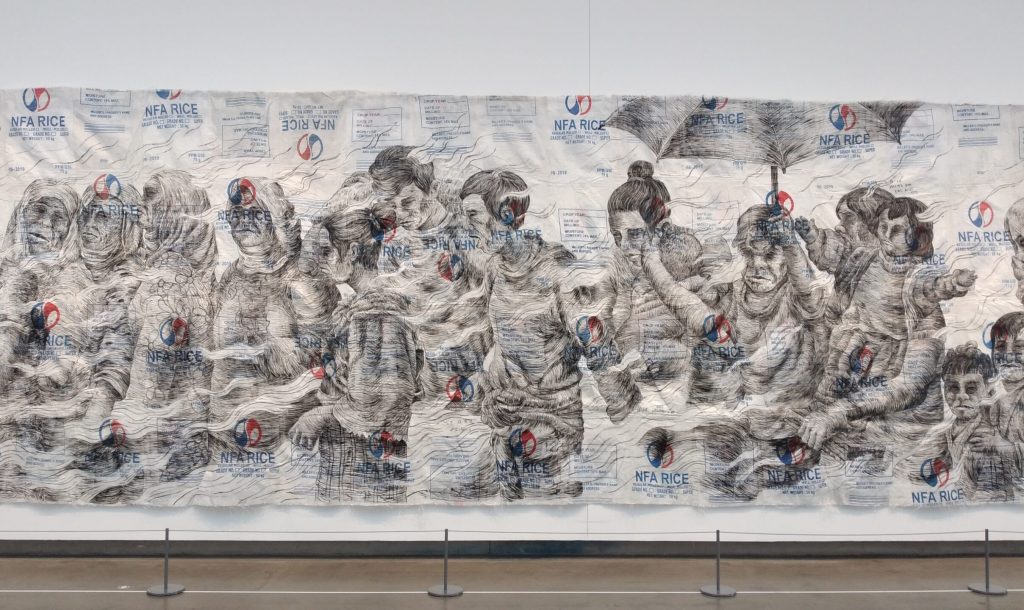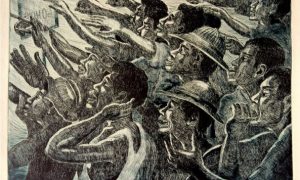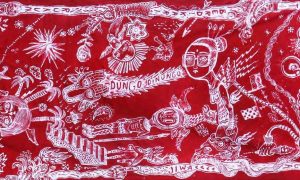The first of three articles on this major recurring exhibition by the author.
At the 10th Asia Pacific Triennial of Contemporary Art (APT10) in Brisbane, the high-ceilinged, brutalist, echoing white walls of the Queensland Art Gallery / Gallery of Modern Art (QAGOMA) have transformed into spaces for play. Across two sites, 150 artists from 30 countries have joined together to probe the issues of the present, and of the futures yet to come.
One such artist is the Kuala Lumpur-based Chong Kim Chiew, whose series of painted maps on tarpaulin, Boundary fluidity (2014–), hangs across and up the expansive walls of the ground-floor long gallery at the Gallery of Modern Art (GOMA). Blue, black and white patterns and lines bring a harmony to the series—the colours of cartography. Looking closer, however, the artist has cut up, blacked out and rearranged place names and geography into imaginary sites.
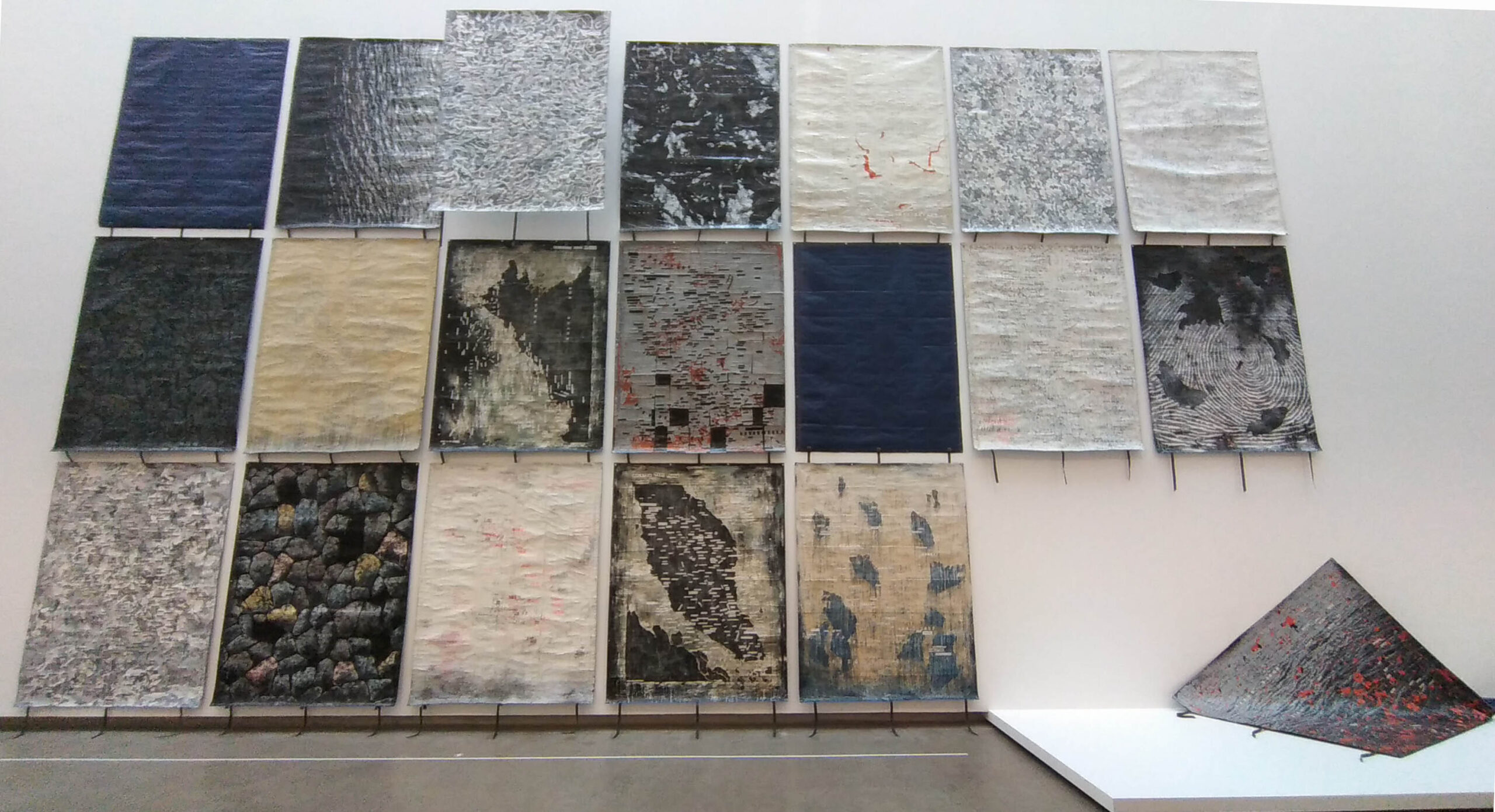
Chong Kim Chiew, Boundary fluidity [multiple works] (2014–). Synthetic polymer paint on tarpaulin. Dimensions variable.
The themes explored in Chong’s series of maps resonate in many artworks at the Triennial. With a curatorial rationale centred on ‘the future of art and the world we inhabit together’, there is an emphasis on the importance of interconnectedness. Although some artworks on display – such as Boundary Fluidity – were made prior to the onset of pandemic restrictions, the experiences of isolation and loss we have all felt over the last two years provide additional ways of reading and elucidating meaning from art. But to look at the art in APT10 solely through the prisms of pandemic life—as some commentators have done in their own analyses of the Triennial—is to miss some other important motivations that have informed the stories behind key works of art, and the meanings we uncover within them.
Across the Triennial, there is a clear emphasis on ideas of journeys, lines, histories, connections and storytelling between one place and another. In many instances, these perspectives are explored through experimental forms and mediums to communicate such ideas; emphasising expressions of curiosity and cosmopolitan thought, and an inquisitiveness that looks out from home to the world beyond.
Blue-and-white
In an alcove at the Queensland Art Gallery (QAG) is a mixed-media installation with ceramics, the space arranged as a shrine. Under the bright radiance of spotlights, royal blue velvet shimmers and the large, gold-and-white ceramic deities placed within the shrine glow. Shrine of Life (2021) is by the Bangkok-born, Melbourne-based artist, Vipoo Srivilasa. To produce Shrine of Life, Srivilasa brought together ideas and visual forms from many different sources: including the culture and stories of Thailand and his Buddhist faith, influences from Australian art, and his connections to the LGBTIQ community.
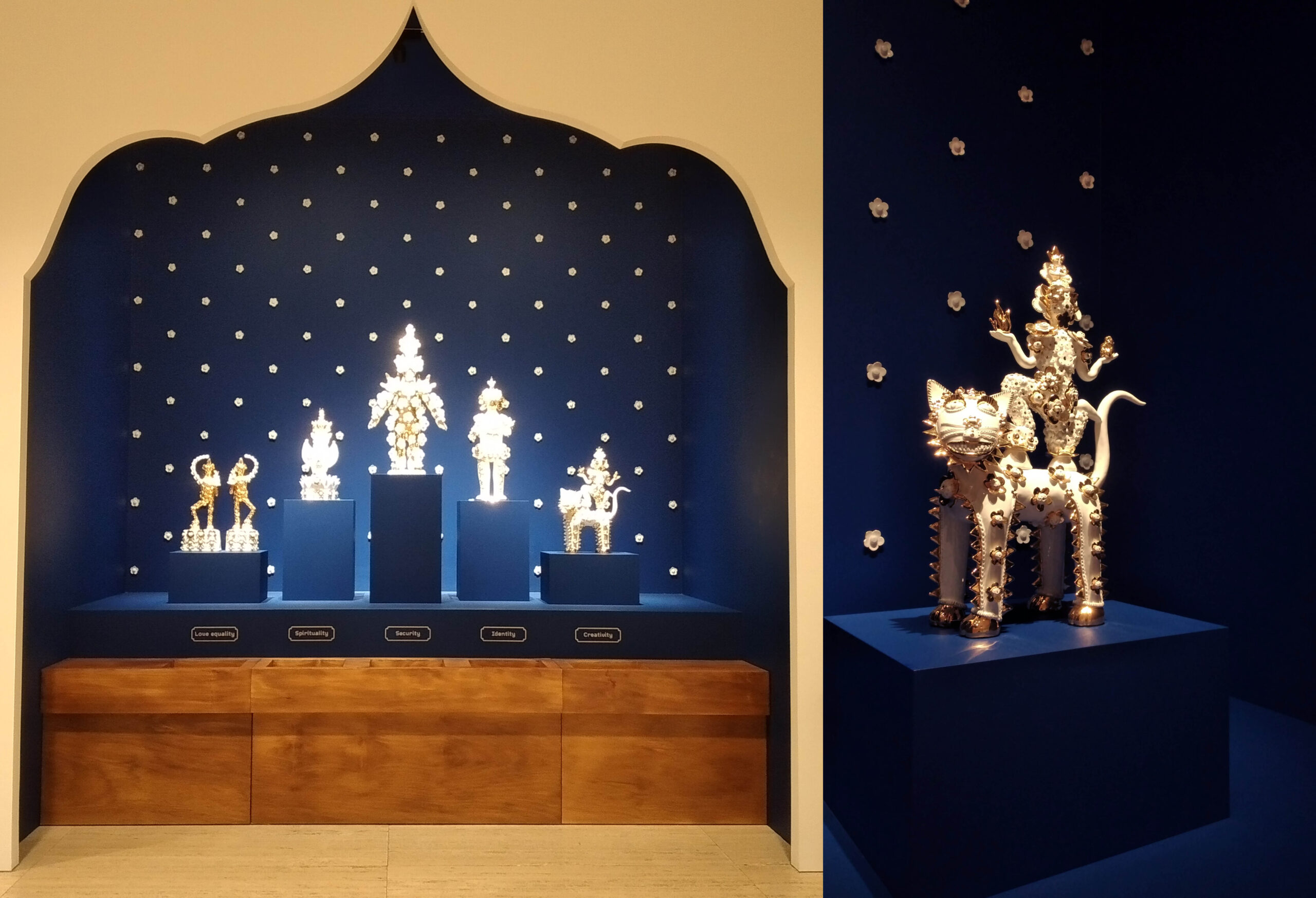
Vipoo Srivilasa, Shrine of Life (2021). Mixed media installation with five ceramic deities. Dimensions variable.
In the palette of blue, gold and white, there is a nod to Lai Krarm—Thai domestic tableware—a recurring motif in the artist’s work. But the artist acknowledges too a direct reference in blue-and-white to the ostentatious, celebrated form of Chinese porcelain that also uses this palette: a ceramic technique that originated in the early 14th Century, during the Yuan dynasty. These valuable goods were so admired that they were later traded along the Silk Roads to the Middle East, and were—later still—exported to Europe in the Early Modern period for specific, interested, ruling-class markets of Chinese export porcelain.
Through the status of export porcelain as a sought-after treasure and commodity in Europe in the early-modern period, it is difficult to escape uncomfortable associations with ideas of expansionism and the “exotic”, ideas which Srivilasa probes within his broader practice and in other works of art. But here, Srivilasa uses the metaphor of border-crossing blue-and-white to explore ideas of cross-cultural connections from East to West, and his own travels from Thailand to Australia. In an article for Garland Magazine, Srivilasa commented that “nowadays … I find it hard to tell which culture is which in my work”; speaking to ideas of hybridity.
Srivilasa’s practice meshes sacred and secular ideals, with the five contemporary deities representing love equality, spirituality, security, identity, and creativity—qualities that are of special significance to the artist. He invites viewers to make an “offering” to the deities in the form of a paper flower, invoking participatory elements. In doing so, the artist creates a space for reflection on ideas of devotion, and on the journeys-through-life all of us have embarked upon. In this way, the language and metaphor of blue-and-white is apt to explore themes of personal travel and movement, and also to articulate and convey ideas of not only being in the world, but belonging within it too.
Sound
Back at GOMA, Bandung-based artist Bagus Pandega’s artwork is making some noise—literally. On the third floor at the River Lounge is an immersive sound artwork that brings together lighting, sound, tea plants, kinetic and machine elements to create a complex mixed-media installation. A Diasporic Mythology (2021) uses sound to explore historical roots, routes and exchanges between Indonesia and Japan, drawing on connections through music as a point of inspiration and departure.
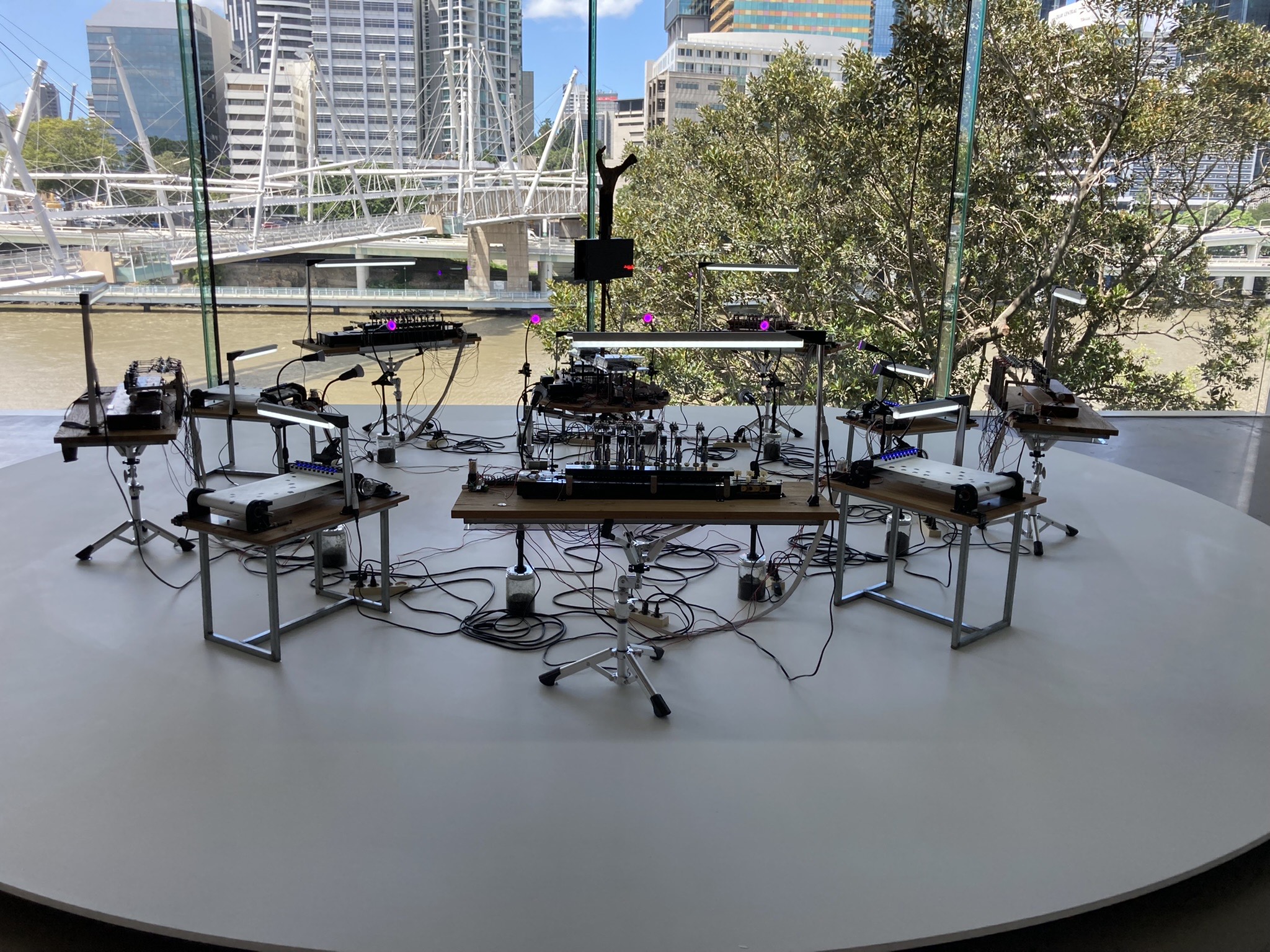
Bagus Pandega, A Diasporic Mythology (2021), Mixed media installation; with string instruments (Taishogoto, Mandaliong, Balinese Penting, Kecapi Sijobang, Lombok Penting), tea plants, LED screens, motors, solenoids, MIDI Sprout, custom electronic and mechanical systems, glass jar, vinyl paper, custom 3D-printed parts, steel, teak wood, copper, acrylic, and instrument stand. Dimensions variable.
A Diasporic Mythology stems from the artist’s fascination with a particular form of Japanese koto instrument, which is known as a Taishogoto. These instruments date back to the Taisho period in Japan, from 1912 to 1926. Bagus has searched in Indonesia for instruments similar to and modelled off the form of a Taishogoto, but which are unique to Indonesian locations and cultures. He brings his findings together in this installation; the assemblage of instruments includes a Balinese Penting, Lombok Penting, Kecapi Sijobang and Mandaliong brought together in dialogue with a Japanese Taishogoto.
Japanese tea plants are placed at the centre of the artwork. Bagus has connected the plants to kinetic and sonic parts of the installation through MIDI sprouts—technology that converts bio-information from plants into data, which in turn is transposed into musical arrangement. These sensors follow musical notations on paper rolls, which triggers a process where technology can work to automate and play sound from the instruments. Then, a cacophony.
The placement of tea plants signifies the long histories and cultural influences that weave between the two nations. These are not always positive markers. In the late 1600s, the first tea seeds were brought to Indonesia from Japan by the German botanist, Andreas Cleyer, who worked for the Dutch East India Company (VOC). Tea plants were brought to Indonesia to serve a decorative function. Later, owing to the growing popularity of this plant as a beverage and in food, more tea plantations would be established in Java as attempts to set up commercial enterprises that rivalled colonial plantations elsewhere in the world. Of course, there is also another point of tension and dark history from modern times that is implicit in this artwork, too: namely, the Japanese occupation of the Dutch East Indies from 1942 to 1945.
Although the tensions in Indonesian and Japanese shared histories are evident in this artwork, there is also an acknowledgement of the many ways that Japanese cultural life has integrated with Indonesian cultural practices and vice versa over the centuries. A Diasporic Mythology makes visible the cultural impacts of this exchange on music and its histories across the archipelago. Through a highly experimental, immersive form of contemporary art, Bagus offers a multisensory environment through which to reflect on the forms and meanings of cross-cultural links, and articulates the history of these connections in a surprising and novel way.
Movement
Five paintings by the Sydney-based and Sidoarjo-born artist, Jumaadi, are also featured at APT10. Using simplified, pared-back materials of cotton cloth and acrylic paint, the emphasis of the artwork stays unwaveringly on the shimmering qualities of warmth and storytelling that are characteristic of his artworks. Across his practice, Jumaadi has worked with mediums such as painting, puppetry, music and poetry in order to offer visual stories that emphasise imagination and observation. Through these mediums, he explores such themes as migration, family, connection and the environment, bringing together Javanese and Australian influences and materials to do so.
For over a decade, Jumaadi has collaborated with artisans from the Kamasan villiage in eastern Bali, home to the traditional forms of Kamasan painting. This is a style of painting for illustrating religious teachings and also for ceremonies, and derives from painting styles of the Hindu-Buddhist kingdom of Majapahit in East Java. Jumaadi has ancestral connections to Majapahit and has found the experience of working at Kamasan a way to connect to these traditions. For APT10, Jumaadi has painted on Kamasan cloth, blending these age-old ways-of-working with contemporary painting techniques and subject matter. It is in the final painting of the series, Flying artist (2021), that ideas of storytelling, connection, movement and make-believe take flight.
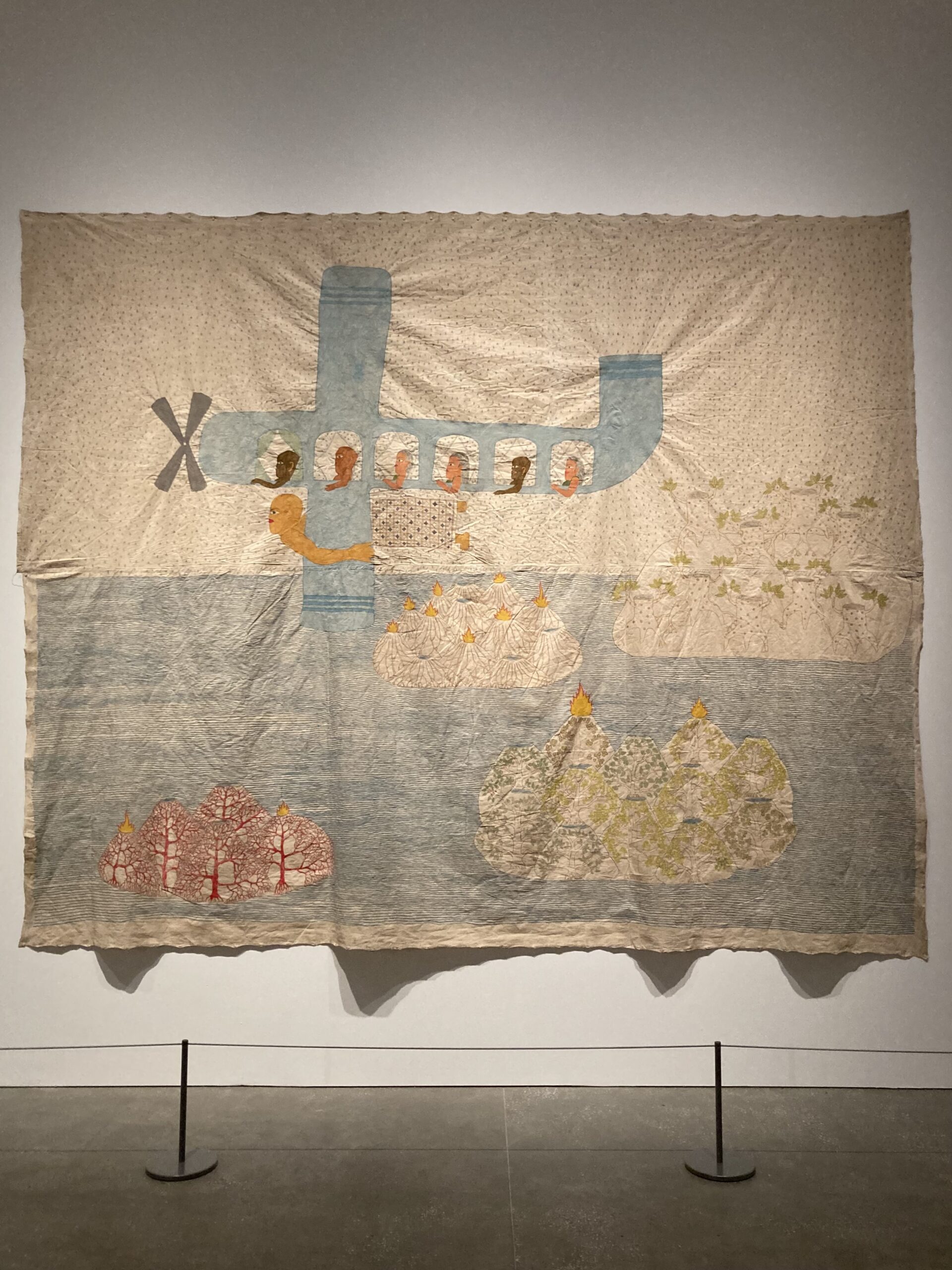
Jumaadi, Flying artist (2021), Synthetic polymer paint on cotton Kamasan cloth, primed with rice paste. 308 x 386 cm.
In the centre, the horizon; beneath, the sun-drenched waves. Clear, bright, rippling across the picture surface in lines and breaks. Islands dot the water; untouched, volcanic, and the use of motifs such as trees, leaves and blood vessels represent “the beauty of time and geographic location”. Above, amongst the stars, the artist carries an aeroplane on his back, moving and gliding across the sky.
Flying artist uses the ideas and visual language of dreams, a constant theme and pattern within Jumaadi’s practice. In this composition, there is a reference to the early blueprint for a flying machine, dreamed up by the Renaissance artist, Leonardo da Vinci. As the flight path keeps moving and the islands drift below, the artist stares straight ahead in solitude, focused and steering with unwavering attention.
Although Jumaadi intends the references to da Vinci and ideas of loneliness in this work to be a critique of the “artist-as-hero” trope, there is too a feeling of community and transit that also shines through within this painting. In these ways, Flying artist presents an opportunity to reflect on the many ways that art, invention and travel have shaped our worlds and communities, and the creative influences and movements that underpin them.
The works of art at APT10 provide us with the time and space to contemplate the links between here and elsewhere—between Australia and Southeast Asia, and Southeast Asia and the world. In exploring and articulating ideas of beyond-ness, APT10 forces us to look past the categories of nation or ethnicity to embrace perspectives in life that are centred on multiplicity and hybridity, on community and friendship. Jumaadi and Vipoo Srivilasa express these ideas through a fusion of contemporary art practice, traditional ways-of-working, and ideas of personal travel and storytelling. Bagus Pandega’s sonic installation draws on experimental art forms to convey deeper understandings of migration, movement, and cross-cultural connections. Meanwhile, in Boundary Fluidity, Chong Kim Chiew unmaps, disorganises, and redraws the world; in the process, playing with the concepts and visual forms of lines, text and borders. In each of these artworks, the viewpoints put forward by the artists voice visions for the future that embrace new ways of thinking about relations to places, people, and communities.
APT10 is showing at the Queensland Art Gallery / Gallery of Modern Art until the 24th of April. All images are provided by New Mandala.
 Facebook
Facebook  Twitter
Twitter  Soundcloud
Soundcloud  Youtube
Youtube  Rss
Rss 